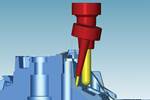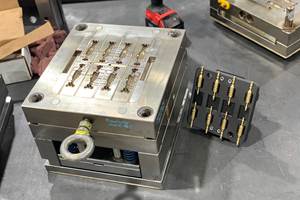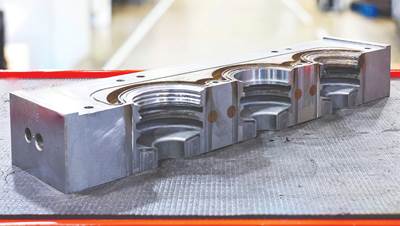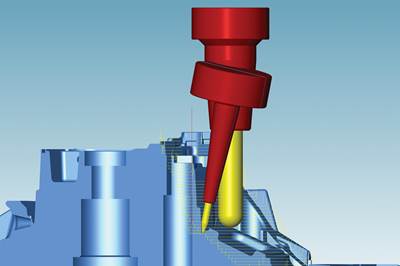2024 Software Suite Update Optimizes Tool Paths, Machining Capabilities
Open Mind brings updates to hyperMILL, with enhanced core toolpath strategies as well as new functionality for increased NC programming efficiency.
In three- and five-axis machining (image), new algorithms for rest material detection ensure that all rest material areas are automatically accounted for in full. Source (All Images) | Open Mind Technologies
Open Mind Technologies brings customers the latest hyperMILL 2024 CAD/CAM software suite which includes a range of enhancements to its core toolpath capabilities, as well as new functionality for increased NC programming efficiency in applications ranging from 2.5D machining to five-axis milling to optimize the digital process chain and manufacturing operations.
An optimized deep-hole drilling CAM strategy offers improved machining reliability by providing a user-friendly interface with process-relevant parameters clearly defined on a new process tab. New capabilities enable coolant and dwell time stages to be identified, allow a chip break to be integrated into a drilling process and more. A new single-tip gundrill tool simulation function provides precise collision checking and a detailed visualization of the stock removal.
Moreover, a new algorithm for three- and five-axis rest machining ensures automatic, complete detection of all rest material areas, in addition to optimized toolpath calculations for faster, reliable machining. Toolpaths are now optimally divided to ensure more efficient machining, and the detection of intersection areas where paths meet has been optimized for collision avoidance.
An additional toolpath improvement is an enhanced path layout for the 3D plane machining cycle. The new strategy has a smoother path and fewer pick-ups. While the toolpath length (distance) may be longer in some cases, the machining time, as tested on a variety of NC controllers, has been reduced.
Open Mind also brings a novel generation of programming assistance and analysis, “CAM Plan,” which simplifies various programming tasks and identifies possible sources of error. Predefined workflow steps safely guide users through the preparation and programming process, while the geometries and features required are automatically created. Also, potential errors are flagged for removal such as double surfaces or gaps between model patches.
Once the data is organized, the CAM workflow can be processed with more intelligence and higher efficiency, according to the company. With the CAM Plan, component topology is analyzed to produce a precise tool path that has command locations aligned with key geometric features and with optimized point distribution for milling. The result is improved surface finishes, easier processing by NC controllers and reduced machining times.
For easy generation of three- and five-axis NC programs with axis change and an optimized use of the workspace, the NC Optimizer feature in the hyperMILL Virtual Machining strategy now offers the option to transform X- and Y-axis movements into a single movement with the rotation axis in the table. By swapping axes, an XY movement is transformed into a simultaneous CX movement which eliminates rewind movements during machining. This is especially impactful on machines that have a limited linear axis range.
The reading back of measuring points when using hyperMILL Virtual Machining is a new feature that enables graphical representation of measured points on the part model, rather than comparing a list of measurement results. Users can also quickly identify measuring points that are out of tolerance on a 3D part model and compare trends over sequential measurements. As a result, it is made easier to analyze and compensate for inaccuracies and tool wear after milling.
Related Content
Moldmakers Deserve a Total Production Solution
Stability, spindle speed and software are essential consideration for your moldmaking machine tool.
Read MoreSmall, Agile Mold Builder Keeps Speed and Accuracy at the Forefront
Michigan-based Zero Tolerance tests the limits of moldmaking and molding with teamwork and technology that permits changes on the fly.
Read MoreDevelopments in High-Speed Machining Technology
There have been many exciting developments in high-speed machining relative to machining centers and controls, tooling and CAD/CAM systems.
Read MoreHow to Eliminate Chatter
Here are techniques commonly used to combat chatter and guidelines to establish a foundation for optimizing the moldmaking process.
Read MoreRead Next
Hybrid CAM Strategy Enables High-Quality, Efficient Mold Repair
As CAM technology requirements accelerate, and the market for additive/hybrid processes evolves, Open Mind highlights its hyperMILL for efficient repair or rework of molds.
Read MoreHow to Implement Five-Axis Mold Machining for Higher Productivity, Versatility
Understanding the basics of five-axis capabilities justifies the investment, but exploring all the multi-axis machine benefits and approaches enhances the return on investment.
Read MoreHow to Use Strategic Planning Tools, Data to Manage the Human Side of Business
Q&A with Marion Wells, MMT EAB member and founder of Human Asset Management.
Read More

















.png;maxWidth=300;quality=90)

.jpg;maxWidth=300;quality=90)








